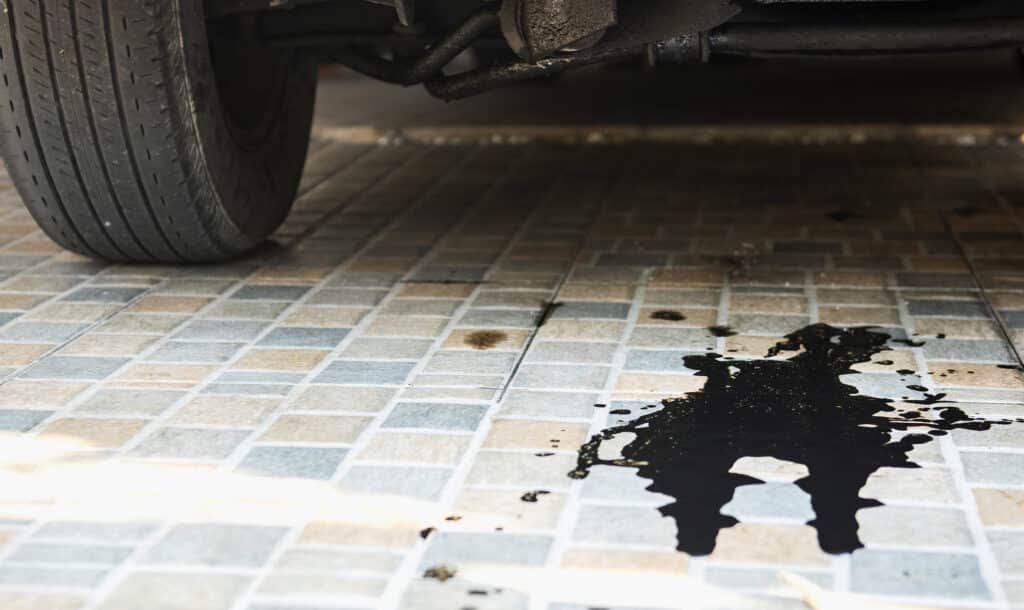Is your car leaving mysterious dark puddles on your driveway or garage floor? You might have an oil leak, and ignoring it could lead to serious engine damage.
Oil leaks are one of the most common car problems, but they can be tricky to diagnose and fix. Many car owners don’t know the warning signs or what to do when they spot a leak.
In this comprehensive guide, we’ll explain the telltale symptoms of an oil leak and provide step-by-step instructions on identifying and repairing the problem’s source.
By the end of this article, you’ll have the knowledge and confidence to tackle this issue head-on.
Keep reading to learn how to protect your car’s engine and avoid costly repairs down the road.
What are the General Signs of Your Car Leaking Oil?
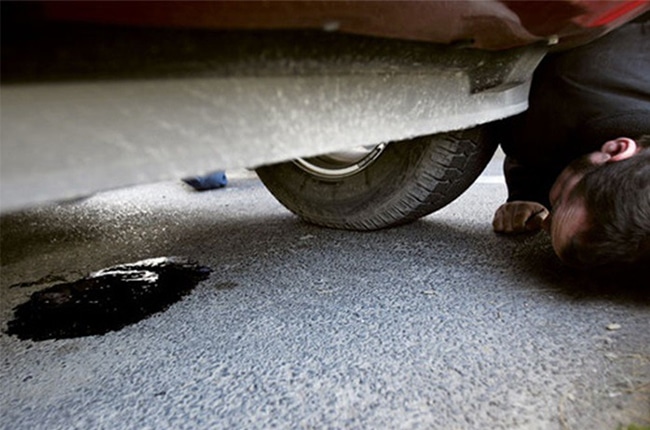
Identifying an oil leak early can save you from costly engine repairs and breakdowns.
While some leaks may be small and hard to detect, several common signs indicate your car is losing oil.
By familiarizing yourself with these symptoms, you’ll be better equipped to address the issue promptly and prevent further damage to your vehicle.
This section will discuss five key indicators that your car may leak oil.
1. Darkish Brown and Black Puddles Under the Car
One of the most obvious signs of an oil leak is the appearance of dark brown or black puddles beneath your vehicle when it’s parked.
These puddles typically have a slick, greasy texture and can range in size depending on the severity of the leak.
If you consistently notice such puddles after you’ve parked your car for a while, it’s a strong indication that oil is escaping from your engine.
2. Burning and Foul Smell
If your car’s oil leaks, you may notice a distinct burning smell while driving or after turning off the engine.
This odor occurs when leaking oil comes into contact with hot engine components, causing it to burn and emit an unpleasant scent.
The smell may be particularly noticeable when your car is idling or after long drives.
If you detect an unusual burning odor, it’s best to investigate the source immediately.
3. Consistent Low Level of Oil
Regularly checking your oil level is a good habit to maintain the health of your engine.
If your oil level is consistently low or you must top it off more frequently than usual, it could indicate an oil leak.
While some oil consumption is normal, especially in older vehicles, a sudden increase in oil loss points to a potential leak that needs attention.
4. Different Appearance of the Oil
When checking your oil level, pay attention to the color and consistency of the oil on the dipstick.
If the oil appears dark, gritty, or has a milky, foamy texture, it could indicate a problem.
Dark, dirty oil may suggest it’s time for an oil change, while a milky appearance could indicate a coolant leak mixing with the oil.
These changes in oil appearance, combined with low levels, can help you identify potential leaks more easily.
5. Oil Pressure Lights are On
Modern vehicles are equipped with warning lights on the dashboard that alert you to potential issues, including low oil pressure.
If your oil pressure light comes on while driving, your engine is not receiving adequate oil pressure, which can be caused by a leak or other factors.
If this light appears, it’s crucial to pull over safely and turn off the engine to prevent damage.
Check your oil level and top it off if necessary, but if the light persists, seek professional assistance.
What Causes the Oil Leaks in Your Car?
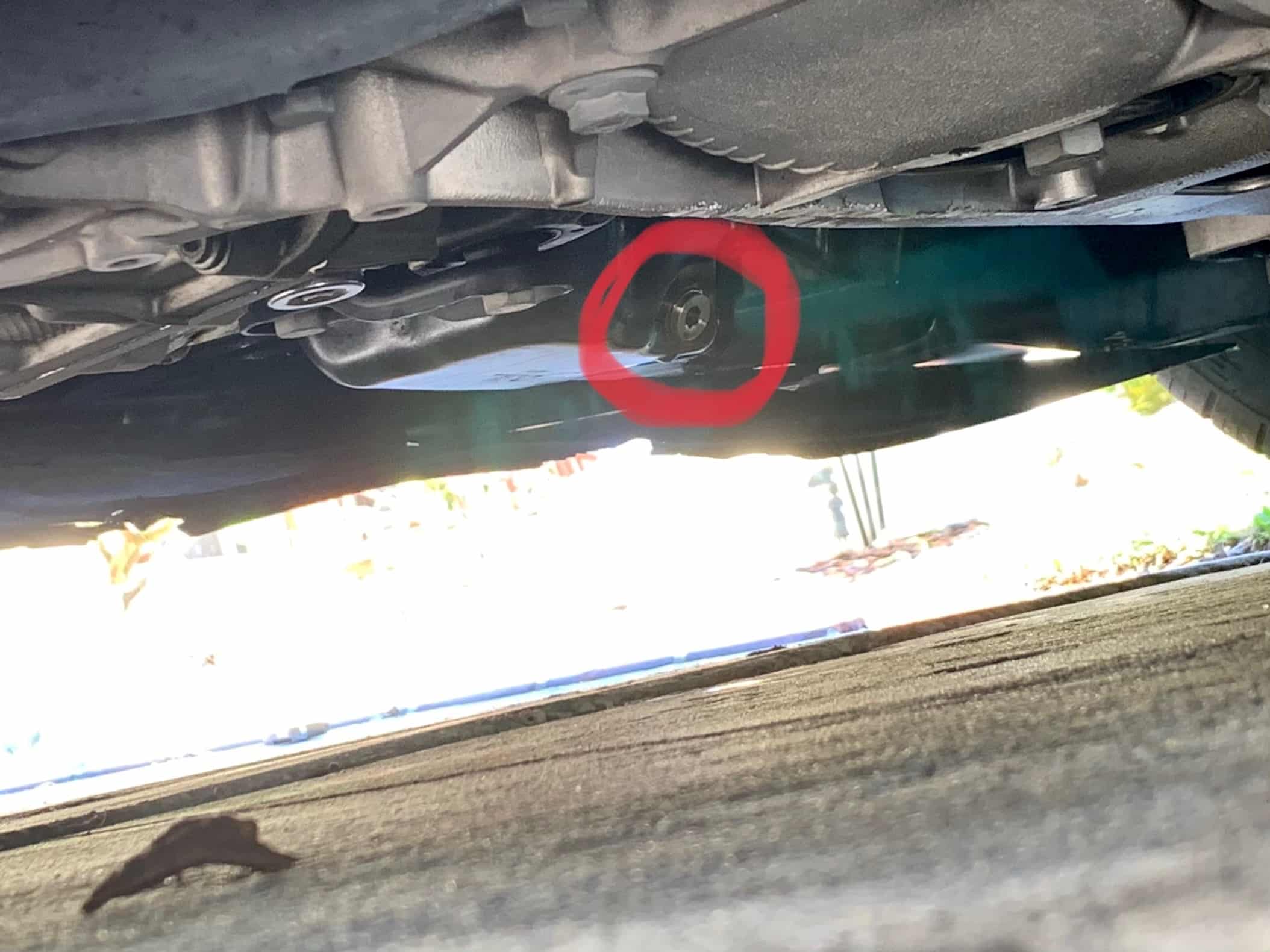
Understanding the common causes of oil leaks can help you better maintain your vehicle and identify potential issues before they escalate.
While there are numerous reasons why your car might be leaking oil, some culprits are more frequent than others.
This section will explore three primary causes of oil leaks: worn-out gaskets, loose or damaged oil drain plugs, and engine faults or cracks.
By familiarizing yourself with these issues, you’ll be better prepared to promptly diagnose and address oil leaks.
1. Worn Out and Damaged Gaskets
Gaskets are essential components in your car’s engine, acting as seals between various parts to prevent oil from escaping.
Over time, these gaskets can become worn out or damaged due to exposure to high temperatures, pressure, and the natural aging process.
The most common gaskets prone to leaks are the valve cover gasket, oil pan gasket, and timing cover gasket.
When these gaskets deteriorate, oil can seep through the gaps and lead to leaks.
Regular inspections and timely replacements of worn gaskets can help prevent such leaks from occurring.
2. Loose and Damaged Oil Drain Plug
The oil drain plug is a small but crucial component at the bottom of your engine’s oil pan.
Its purpose is to allow oil to drain during oil changes and to seal the oil pan when properly tightened.
However, if the drain plug becomes loose or damaged, it can cause oil to leak.
This issue can arise due to overtightening, using an incorrect plug, or damage from road debris.
To prevent leaks from a faulty oil drain plug, ensure that it is tightened to the manufacturer’s recommended torque specifications and replace it if there are signs of damage or stripping.
3. Fault or Cracks in the Engine
Oil leaks can sometimes be caused by more severe issues, such as faults or cracks in the engine block or cylinder head.
These problems can arise from overheating, physical damage, or manufacturing defects.
For example, a cracked engine block can allow oil to escape and mix with coolant, leading to other problems.
Similarly, a warped or cracked cylinder head can compromise the seal between the head and the engine block, causing oil to leak.
Such issues often require extensive repairs or even engine replacements, highlighting the importance of regular maintenance and prompt attention to any signs of leaks or engine trouble.
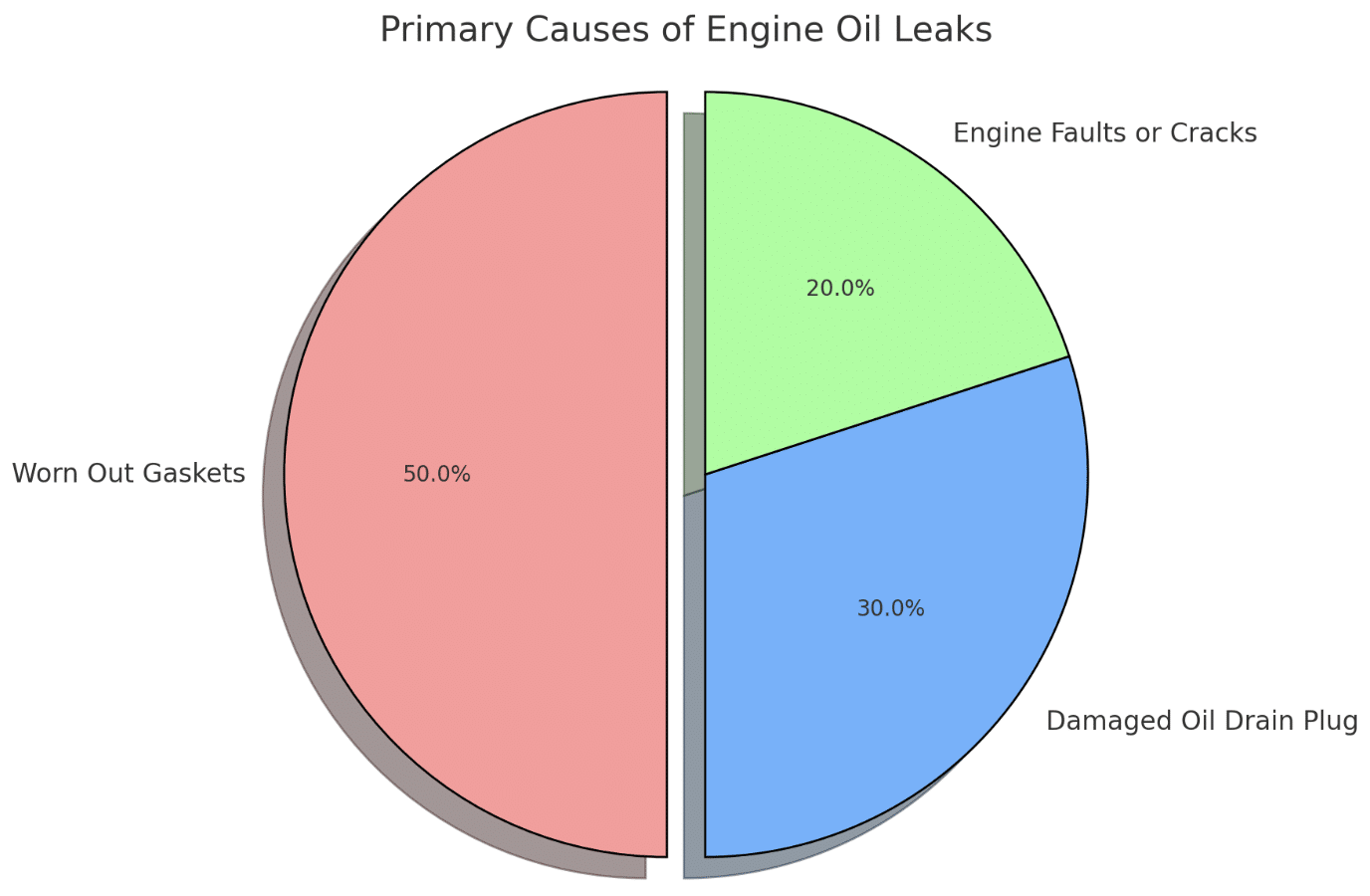
Important Measures to Adopt to Prevent Oil Leaks
Prevention is key when it comes to maintaining your car’s engine and avoiding costly repairs due to oil leaks.
By taking proactive steps and following best practices, you can significantly reduce the risk of oil leaks and extend the life of your vehicle.
In this section, we’ll discuss three crucial measures to prevent oil leaks: avoiding overfilling your oil, using the right type of oil, and conducting routine inspections.
Implementing these strategies will help keep your car running smoothly and efficiently.
- Do Not Overfill Your Oil: One common mistake car owners make is overfilling engine oil. While it may seem harmless, adding too much oil can lead to leaks and other problems. When there’s excess oil in the engine, it can cause pressure to build up, forcing oil to escape through seals and gaskets. Additionally, overfilling can cause the crankshaft to come into contact with the oil, causing it to foam and lose its lubricating properties. To prevent these issues, always check your oil level using the dipstick and add oil gradually, ensuring it remains within the recommended range indicated by the dipstick markings.
- Use The Right Type Of Oil: Using the correct oil for your car’s engine is crucial for preventing leaks and maintaining optimal performance. Different engines require specific oil viscosities and formulations outlined in your vehicle’s owner’s manual. Using the wrong type of oil can lead to increased wear and tear on engine components and leaks due to incompatibility with seals and gaskets. Always refer to your manual or consult a professional mechanic to determine the appropriate oil type for your car.
- Conduct Routine Inspections: Regular inspections are essential for identifying potential oil leaks early on and preventing them from worsening. Check your parking area for any signs of oil stains or puddles, as this can indicate a leak. Regularly check your oil level and condition using the dipstick, looking for any changes in color or consistency that may suggest contamination or leaks.
What are the Ways to Fix Oil Leaks in Your Car
When you’ve identified an oil leak in your car, it’s essential to take action to fix the problem and prevent further damage to your engine.
In this section, we’ll explore two main approaches to addressing oil leaks: adding oil as needed and finding and repairing the source of the leak.
We’ll provide a step-by-step guide on adding oil to your engine and discuss the importance of identifying and fixing the leak’s root cause.
By following these strategies, you can effectively manage and resolve oil leaks in your vehicle.
1. Add Oil as Needed
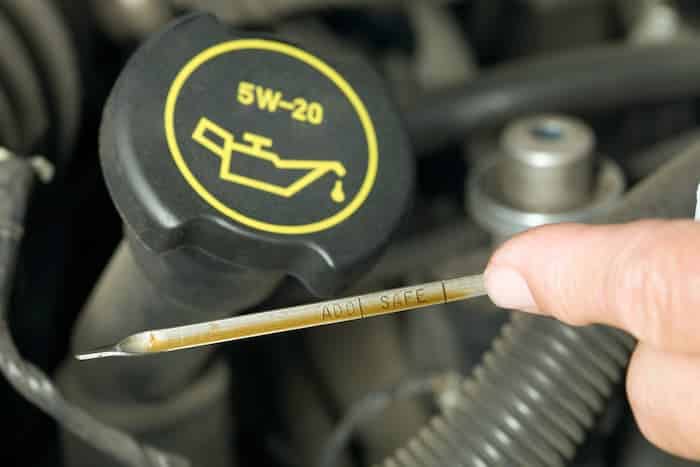
If you’ve noticed that your car is leaking oil, one temporary solution is to add oil to your engine to maintain proper levels.
This approach can help prevent engine damage while you work on identifying and fixing the source of the leak.
However, it’s crucial to understand that adding oil is only a short-term fix and should not be relied upon as a permanent solution.
Step-by-Step Guide on How to Add Oil
- Park your car on a level surface and turn off the engine.
- Open the hood and locate the oil dipstick.
- Remove the dipstick, wipe it clean with a lint-free cloth, and reinsert it fully.
- Remove the dipstick again and check the oil level. It should be between the minimum and maximum markings.
- If the level is low, locate and remove the oil filler cap on top of the engine.
- Using a funnel, carefully pour the recommended type of oil into the engine, checking the level with the dipstick as you go.
- Once the oil level is within the proper range, securely replace the oil filler cap and dipstick.
Temporary versus Permanent Solutions
While adding oil can temporarily alleviate the symptoms of an oil leak, it is not a permanent solution.
Continuously adding oil without addressing the underlying issue can lead to more severe problems, such as engine damage or failure.
It’s essential to use this method only as a stopgap measure while you work on identifying and repairing the source of the leak.
Regularly monitoring your oil level and monitoring for any changes in the severity of the leak is crucial during this time.
2. Find and Repair the Source of the Leak
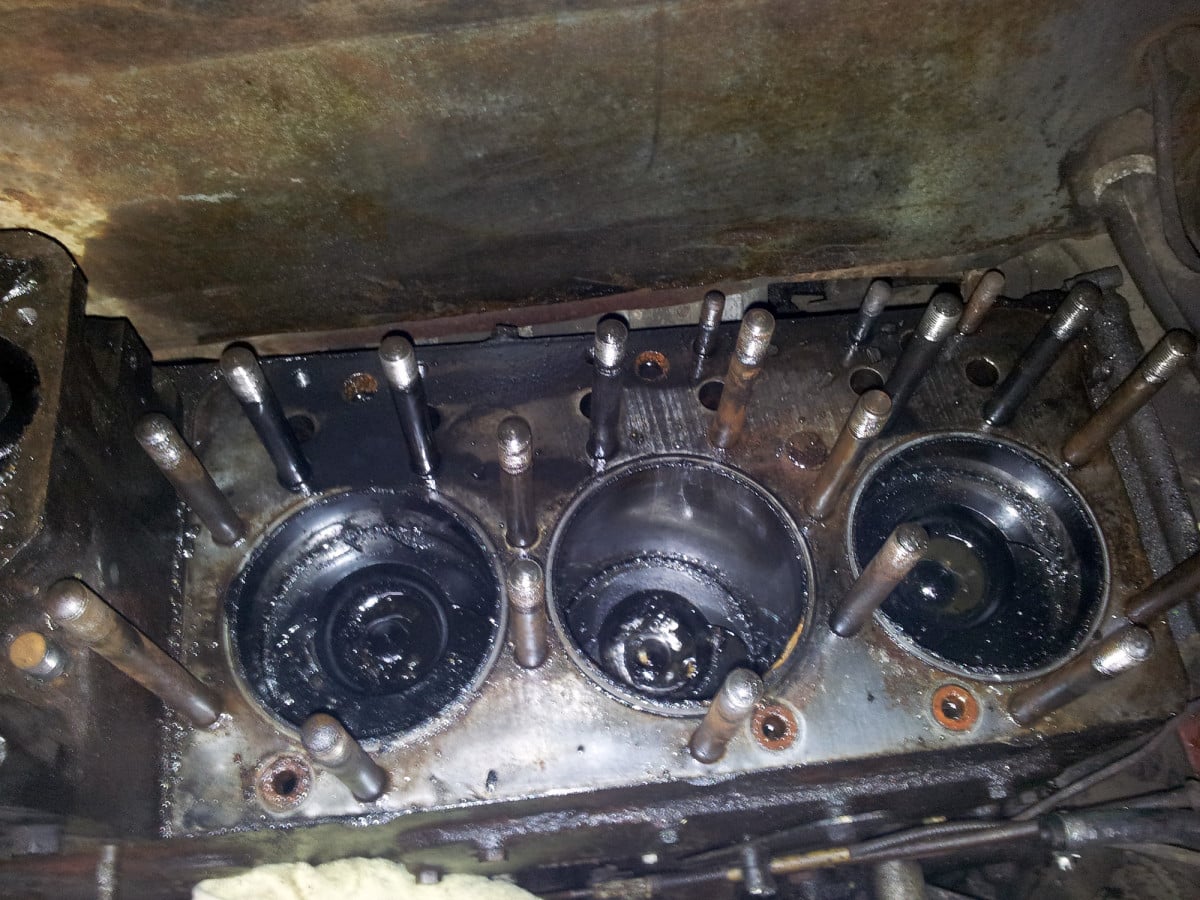
To effectively resolve an oil leak, it’s necessary to identify and repair the root cause of the problem.
This process may require the expertise of a professional mechanic with the knowledge and tools to accurately diagnose and fix the issue.
However, understanding the importance of addressing the source of the leak and being aware of common problem areas can help you make informed decisions about your vehicle’s maintenance.
Importance of Identifying and Fixing the Root Cause
Identifying and repairing the source of an oil leak is crucial for several reasons. First, it prevents the leak from worsening and causing more damage to your engine.
Second, it helps maintain your car’s efficiency and performance, as oil leaks can lead to reduced oil pressure and increased engine wear.
Finally, addressing the root cause of the leak can save you money in the long run by preventing the need for more costly repairs down the line.
Common Areas to Check for Leaks and Potential Repairs
When inspecting your car for oil leaks, there are several common areas to check:
- Valve Cover Gaskets: These gaskets can deteriorate over time, allowing oil to seep out. Replacing the gaskets is a relatively simple repair.
- Oil Pan Gasket: A damaged or worn oil pan gasket can cause leaks at the bottom of the engine. Replacing the gasket usually requires removing the oil pan.
- Timing Cover Seal: If the timing cover seal is damaged or worn, oil can leak from the front of the engine. Replacing the seal is often necessary to fix this issue.
- Oil Filter and Drain Plug: Loose or improperly installed oil filters or drain plugs can cause leaks. Properly tightening and replacing these components during oil changes can prevent such leaks.
- Crankshaft Seals: Worn or damaged crankshaft seals can allow oil to leak from the front or rear of the engine. Replacing these seals can be a more involved repair.
If you’re unsure about the source of the leak or how to repair it, consult a trusted mechanic.
They can accurately diagnose the problem and recommend the most appropriate action to fix the oil leak and ensure your car’s long-term health.
Wrapping it Up
Understanding the symptoms of a car oil leak and how to fix it is crucial for maintaining your vehicle’s health and longevity.
By familiarizing yourself with the signs of leaking oil, such as dark puddles under your car and unusual oil appearance, you can quickly identify and address the issue before it leads to more serious engine problems.
Taking preventive measures, like using the correct oil type, avoiding overfilling, and conducting regular inspections, can significantly reduce the risk of oil leaks.
If you encounter a car leaking oil, remember to add oil as needed for a temporary fix and then focus on identifying and repairing the root cause to ensure your vehicle’s long-term performance and reliability.

